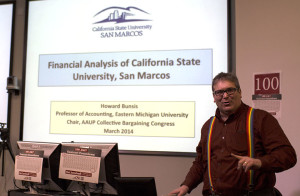
By Katlin Sweeney
Editor-in-Chief
A collection of faculty and staff sat down recently for a presentation that would explore how the money at CSUSM is being spent.
On March 27, Professor Howard Bunsis spoke to the group about the calculations he computed as to the status of CSUSM’s financial affairs. He is an accounting professor from Eastern Michigan University and the chair of the AAUP Collective Bargaining Congress, which seeks to bring helpful information to support academic employees.
Bunsis calculated a total $16 billion in assets for the CSU system, extra cash reserves being generated because of the furlough days that occurred back in 2011. Specifically at CSUSM, he computed that the school has $330 million in assets, $230 million in total net assets and $75 million in total liabilities. The majority of CSUSM’s total revenue is generated at $158 million from tuition and fees at 39 percent, state appropriation money at 32 percent and pell grants at 12 percent.
Bunsis reported that based upon his calculations, the CSU system and CSUSM are not broke by any stretch. With how much money has been saved, he predicted that even if all money stopped coming to the university, CSUSM could afford to pay everyone and maintain the energy in all of the buildings for two months.
Out of the total amount being spent on CSUSM expenses, the major portions of the budget are 32.7 percent for instruction, 16.6 percent for scholarships, 11.6 percent for academic support (pays for deans, associate deans, counselors, advisers, etc.) and 11.3 percent goes to instructional support (purely administrators). In addition to that, 8.1 percent goes to student services, 7 percent to depreciation and 2 percent is interest. The largest category by far, at 60.1 percent, pays for the salaries of all people employed by the university.
Bunsis calculated the 20 highest paying salaries in 2013, positions including vice presidents and deans. The highest salary went to President Haynes at $346,000. Bunsis showed that the total amount necessary to pay the top twenty employees is $3,5,18,000, the mean salary being $175,900. He also found that while these salaries were steady for the highest paid employees, the majority of new teaching positions are currently being filled by part-time and non-tenure faculty.
CSUSM’s enrollment jumped from 9,159 in 2008 to 11,300 in 2014. 61 percent are female students and 98 percent are from California. The university’s tuition has increased 109 percent from 2006-7 to 2013-14, transitioning from $3,199 per year to the current amount of $6,695. 13 percent of students graduate in four years and 38 percent graduate in five years. The majority of students, according to Bunsis’ figures, at 48 percent, graduate in six years. While it is taking longer than the traditional figure for students to complete their undergraduate degree, CSUSM does harbor a strong graduation rate with more students completing their studies.
The full-length presentation will be available to the public sometime soon.

